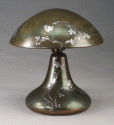Heintz Metalware Continues to Grow in Popularity

In 1902, Otto Heintz set up the Arts & Crafts Shop in Buffalo, New York, where he manufactured modest desk sets, stamp boxes and tall candlesticks decorated with applied enamel over a textured copper surface (not hand-hammered). The enterprising Heintz, who had been trained as a jeweler, soon received three patents for his techniques of attaching the enamel to the metal. Before long, however, Heintz struck upon the idea of switching from copper to bronze, which could be formed by ‘spinning’ on a lathe over a wooden form, and of decorating bronze bowls and vases with silver rather than enamel.
The silver overlay often depicted Arts & Crafts motifs taken from nature and was modeled to compliment the shape of each piece, whether it be a tall, slender bud vase, a low bowl or a pair of bookends. During his experiments with the silver overlay, Heintz discovered that he could bond the overlay to the piece by heating the bronze to a point where the impurities in the metal would attach themselves to the silver before it was then allowed to cool. His technique was later awarded with yet another patent.
The switch from enamel to silver also coincided with a slight change in the company name: the Heintz Art Metal Shop with its now-familiar mark – the initials H.A.M.S. in a diamond over STERLING ON BRONZE, along with the patent date Aug. 27, 1912. Since the forms bearing the Heintz mark were spun on a metal lathe rather than hammered to their desired shape, Otto Heintz developed a number of unique patinas, including Verde (a dark green favored by many Arts & Crafts collectors), Royal Red, Bronze and French Grey to distinguish his work from that of his competitors.
David Surgan (www.heintzcollector.com), for over two decades the most well-known collector and dealer in Heintz metalware, has observed that collectors “generally favor the same sorts of vase forms as they do with pottery, such as bulbous or squat vases, vases with small rim openings, and strong graceful slender forms. Overlay decorations currently in favor tend to be Japanesque, geometric or art nouveau.”
He goes on to say, “As for condition (and condition is everything!!!), small pinprick ‘fleabites,’ scuff marks and surface scratches are far more tolerable than patina degradation or complete patina loss due to an ill-advised polishing. The original patina is a huge plus, especially the distinctive Heintz mottled brown and variegated green patinas.”
“Prices have risen dramatically in the last fifteen years. In today’s market, prices still vary wildly, but a perfect large vase in a desirable form might command $1000 or more, while lamps in perfect condition might command from $1000 to over $15,000 for the mushroom lamp.”
Otto Heintz died unexpectedly in 1918, but the firm survived until 1930. Over the course of nearly three decades of production, the Heintz Art Metal Shop created tens of thousands of examples of forms ranging from bowls, vases, desk sets, ashtrays, lidded cigarette boxes, match boxes and humidors to candlesticks, desk lamps and their famous (and rare) mushroom lamps. Today they represent one of the most affordable accessories in any Arts & Crafts home or office.

